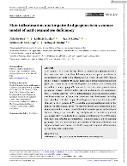Skin inflammation and impaired adipogenesis in a mouse model of acid ceramidase deficiency

Author
Rybová, Jitka
McKillop, William M.
Medin, Jeffrey A.
Publication date
2022Published in
Journal of Inherited Metabolic DiseaseVolume / Issue
45 (6)ISBN / ISSN
ISSN: 0141-8955Metadata
Show full item recordCollections
This publication has a published version with DOI 10.1002/jimd.12552
Abstract
Acid ceramidase catalyzes the degradation of ceramide into sphingosine and a free fatty acid. Acid ceramidase deficiency results in lipid accumulation in many tissues and leads to the development of Farber disease (FD). Typical manifestations of classical FD include formation of subcutaneous nodules and joint contractures as well as the development of a hoarse voice. Healthy skin depends on a unique lipid profile to form a barrier that confers protection from pathogens, prevents excessive water loss, and mediates cell-cell communication. Ceramides comprise similar to 50% of total epidermis lipids and regulate cutaneous homeostasis and inflammation. Abnormal skin development including visual skin lesions has been reported in FD patients, but a detailed study of FD skin has not been performed. We conducted a pathophysiological study of the skin in our mouse model of FD. We observed altered lipid composition in FD skin dominated by accumulation of all studied ceramide species and buildup of abnormal storage structures affecting mainly the dermis. A deficiency of acid ceramidase activity also led to the activation of inflammatory IL-6/JAK/signal transducer and activator of transcription 3 and noncanonical NF-kappa B signaling pathways. Last, we report reduced proliferation of FD mouse fibroblasts and adipose-derived stem/stromal cells (ASC) along with impaired differentiation of ASCs into mature adipocytes.
Keywords
acid ceramidase, adipogenesis, ceramides, Farber disease, macrophages, skin,
Permanent link
https://hdl.handle.net/20.500.14178/1693License
Full text of this result is licensed under: Creative Commons Uveďte původ-Neužívejte dílo komerčně 4.0 International






